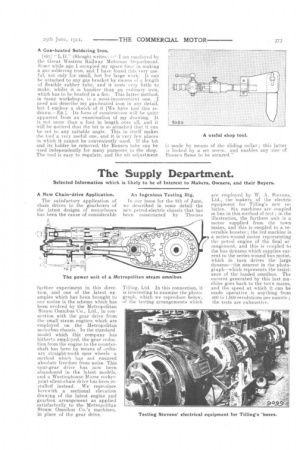The Supply Department.
Page 37

If you've noticed an error in this article please click here to report it so we can fix it.
Selected Information which is likely to be of Interest to Makers, Owners, and their Buyers.
A New Chain-drive Application.
The satisfactory application of chain drives to the gearboxes of the latest designs of motorbuses has been the cause of considerable further experiment in this direction, and one of the latest examples which has been brought to our notice is the scheme which has been evolved by the Metropolitan Strain Omnibus Co., Ltd., in connection with the gear drive, from the small steam engines which are employed on the Metropolitan motorbus chassis. In the standard model which this company has hitherto employed, the gear reduc tion from the engine to the countershaft has been by means of ordinary straight-tooth spur wheels--a method which has not ensured absolute freedom from noise. This spur-gear drive has now been abandoned in the latest models, arid a Westinghouse-Morse rockerjoint, silent-chain drive has been installed instead. We reproduce herewith a sectional elevation drawing of the latest engine and gearbox arrangement as applied satisfactorily to the Metropolitan Steam Omnibus Co.'s machines, in place of the gear drive. An Ingenious Testing Rig.
To our issue for the 8th of June, we described in some detail the new petrol-electric chassis that has been constructed by Thomas Tilling, Ltd. In this connection, it is interesting to examine the photograph, which we reproduce below, of the testing arrangements which are employed by W. A. Stevens, Ltd., the makers of the electric equipment for Tilling's new vehicles. Six machines are coupled in line in this method of test ; in the illustration, the furthest. unit is a motor supplied from the town mains, and this is coupled to a reversible booster ; the 3rd machine is a series-wound motor representing the petrol engine of the final ar rangement, and this is coupled to the bus dynamo which supplies current to the series-wound bus motor, which in turn drives the large dynamo—the nearest in the photograph—which represents the resistance of the loaded omnibus. The current generated by this last machine goes back to the town mains, and the speed at which it can be made operative is anything from 400 to 1,000 revolutions per minute ; the tests are exhaustive.






































